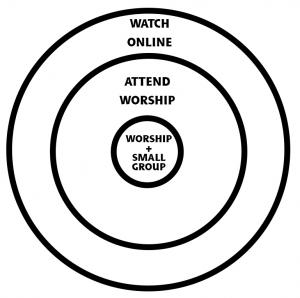
Church is merging with television. I explain how and why this is happening in my previous post.
The good news: thanks to video, gifted communicators are reaching untold millions around the globe. People who might never darken the door of a church can hear the gospel proclaimed anytime, anywhere. Sermon content is now available in almost every language, even in places it’s officially banned.
The bad news: as screen-based preaching proliferates, live church attendance has begun to suffer. Just as the Internet hurt retail stores by discouraging in-person shopping, screen-based preaching has begun to affect attendance, participation and giving to brick-and-mortar churches.
Forty years ago you had to dress up, drive across town and go to a building to receive Christian teaching. These days you can sleep in on Sunday and watch your local service via Facebook Live — wearing your jammies. Or watch it later. Or take in a pre-recorded message from any one of a thousand gifted preachers. Great sermons are just a Google search away.
As more people choose to consume their sermon content online, local churches will come under increasing financial pressure. Volunteer ranks will go unfilled. Big, successful churches are not immune from these trends.
But here’s the greater challenge: a generation of Christians is learning to practice the faith alone.
* * * * *
Church consists of horizontal and vertical experiences. We attend church to meet with God (vertical) and with people (horizontal).
Horizontal experiences make terrible television. But vertical experiences work great on TV, because they can be scripted, timed and quality controlled.
So, fast-growing congregations have been investing heavily in the vertical experience, while removing all things horizontal from their weekly worship services.
What’s in: computer controlled lighting, elaborate stages, smoke machines, high-definition cameras, and concert-quality sound systems.
What’s out: small church practices like asking visitors to stand and be recognized, welcoming new members, taking prayer requests from the congregation, announcements of wedding engagements and births, deaths, etc. Many churches have also eliminated adult Sunday school and formal coffee hours.
In other words, almost everything that facilitates human contact as a part of worship has been scrubbed. All that’s left is a few minutes of chit-chat before and after the service.
Now, contemporary churches aren’t dumb. They recognize the human-contact deficit they’ve created, and have a brilliant solution: the weekly small group.
Sunday is where you get your vertical; midweek small group is where you get your horizontal.
By separating the vertical and the horizontal into two separate meetings, these churches are able to deliver a higher quality experience at both. Great music and preaching on Sunday, coupled with fellowship and support at small group is a powerful combination.
If only it worked that way in real life.
Truth is, relatively few churchgoers attend small groups. Most congregations struggle to get 20% of their weekend attenders actively involved in a midweek group. (Heck, most churches struggle to get their members to church more than twice a month, but that’s a subject for another post)
 So, without realizing it, we are creating a generation of isolated Christians. They watch our services online or attend them on Sunday. But they don’t know any other Christians. They’ve never prayed with another Christian. They’ve never studied with another Christian. They’ve never served alongside another Christian. They’ve never developed a deep friendship with another Christian. They’ve never worked through a conflict with another Christian.
So, without realizing it, we are creating a generation of isolated Christians. They watch our services online or attend them on Sunday. But they don’t know any other Christians. They’ve never prayed with another Christian. They’ve never studied with another Christian. They’ve never served alongside another Christian. They’ve never developed a deep friendship with another Christian. They’ve never worked through a conflict with another Christian.
They are walking alone.
As the virtual world dominates more of our time and attention, church is uniquely positioned to offer genuine face-to-face human contact. People are dying for this. Loneliness is epidemic.
Yet we’ve spent the past forty years removing the human contact from our Sunday services, to make them more attractive to visitors (and for TV).
So here’s the big question: How can we structure a church to deliver both horizontal and vertical in a single meeting – and do it in a way that’s so engaging that people can’t wait to invite their friends?
In a future post I’ll offer a proposal that could help. I’ll share a link to it here as soon as it’s complete.












